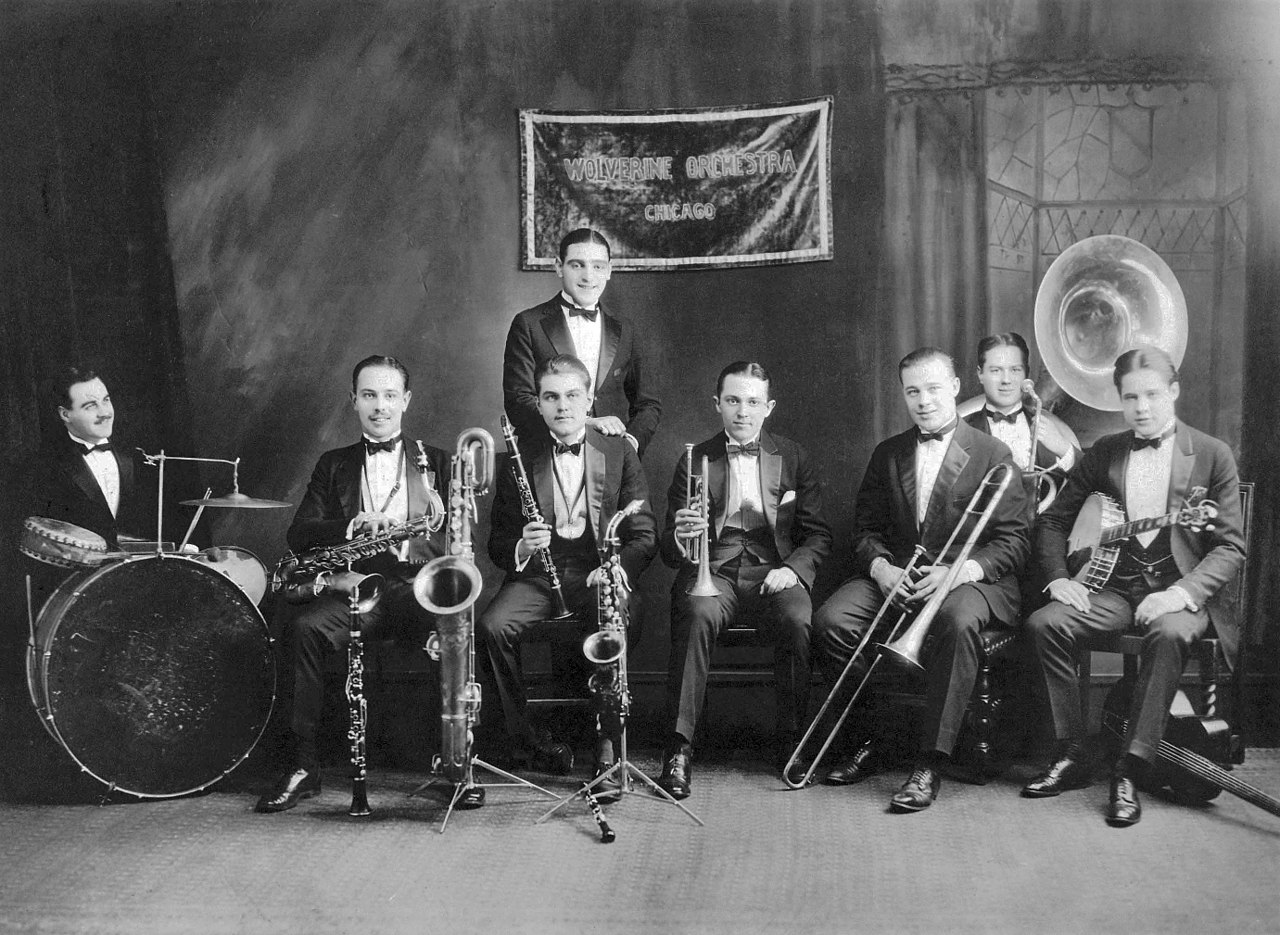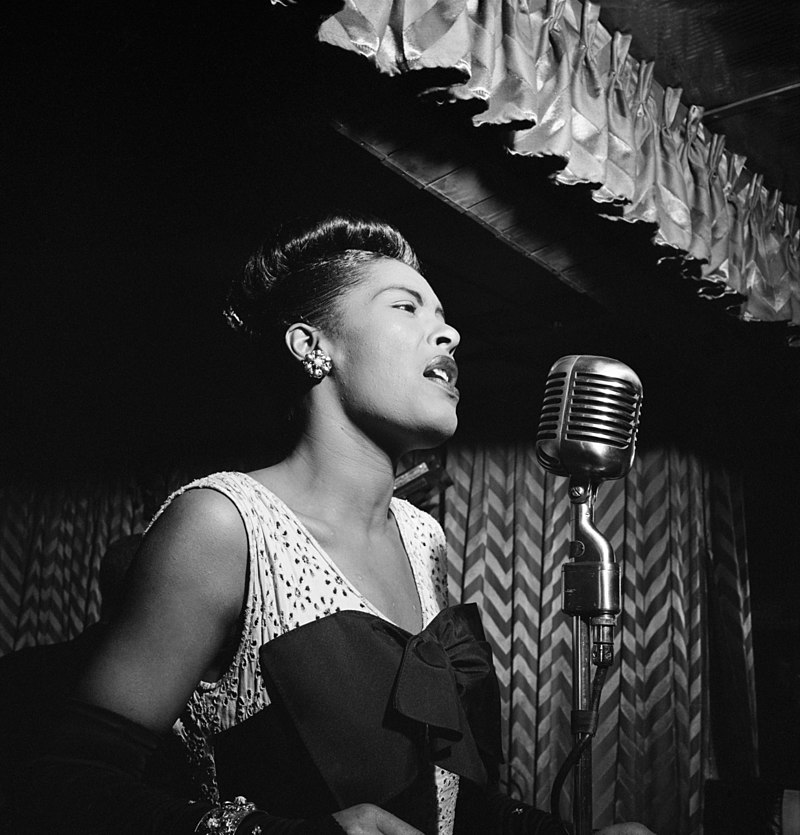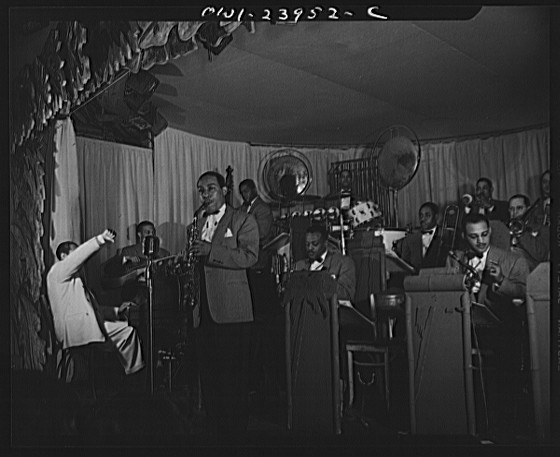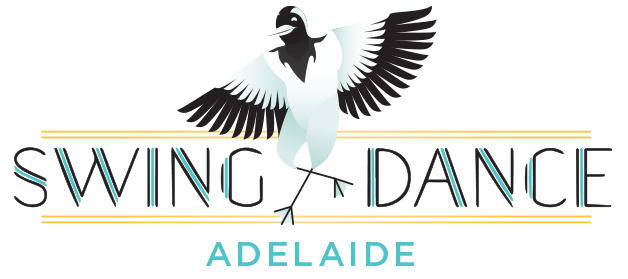The swing and blues dances we enjoy today developed alongside the music created by African Americans and made popular in the United States in the first half of the twentieth century, jazz. We also dance to music by modern artists who continue to play these styles of music.
The Nineteen-Twenties
Jazz music came into popularity in America just after the First World War and into the 1920s.
Starting in New Orleans, jazz was a blend of African and European musical traditions, with roots including blues and ragtime music and incorporating influences from gospel, vaudeville, Tin Pan Alley tunes, and Broadway.
Many African Americans in the 1920s (and continuing into the 1970s) left the South to flee racial violence and segregation and to pursue better opportunities in the Northern states during what is known as the Great Migration. Many jazz and blues musicians from New Orleans moved to Chicago and other Northern cities in this period, including Joe ‘King’ Oliver and Louis Armstrong.


The New York neighbourhood of Harlem was a hub for African American artists, writers and activists during what is known as the Harlem Renaissance. Harlem was also home to some of the most popular ballrooms and night clubs in New York, including the Savoy Ballroom, the Cotton Club, Small’s Paradise and Connie’s Inn. Some of these venues, like the Savoy Ballroom, were integrated, and others, like the Cotton Club, were segregated and only admitted African Americans as performers.
New York-based musicians and arrangers Don Redman and Fletcher Henderson played a major role in popularising elements of big band jazz that we still recognise today. Their arrangements included call and response between the horns, reeds, and rhythm sections, playing solos over harmonies played by the ensemble, and the use of riff-based melodies.
recommended listening
Muskrat Ramble (Remastered): Louis Amstrong and His Hot Five.
Armstrong’s Hot Five Recordings include some stellar performances. Armstrong and his bands helped to popularise some of the most popular jazz standards of the 1920s and 30s, including ‘Stardust’, ‘Ain’t Misbehavin’, and ‘St Louis Blues’.
The Duke: The Columbia Years (1927-1962).
Duke Ellington recorded music solo and with a number of bands in the 1920s. This compilation includes work from throughout his career, including his early work with The Washingtonians and his Orchestra.
Ethel Waters: Sweet Georgia Brown (Original Recordings, 1923-25).
At one point in the 1920s, Ethel Waters was one of the highest-earning women in the entertainment business. This compilation includes lots of good examples of Ethel Waters’ early music with catchy tunes and bawdy lyrics.
Bix Beiderbecke: Volume 1: Singin’ the Blues.
Bix Beiderbecke was a hugely influential trumpet player and bandleader. This is a compilation of Beiderbecke’s major recordings with Frank Trumbauer from the 1920s.
nineteen-thirties & forties
Kansas City, a city renowned for its all-night jam sessions and bands who played improvised ‘head arrangements’, is also considered the origin of one of the most influential innovations in jazz music in the late 1920s and early 1930s: swing rhythm. Swing went on to dominate popular jazz music for the next two decades.
Kansas City was home to bands including the Bennie Moten Orchestra, Andy Kirk and his Clouds of Joy, and the pianist, composer and arranger Mary Lou Williams. Count Basie, who played in Bennie Moten’s Band, went on to form his own band and hired many musicians who had worked in Kansas City or had played in Territory Bands throughout the Midwest, including Jimmy Rushing, Walter Page, Lester Young, and Herschel Evans.

One O’Clock Jump – Count Basie and his Orchestra
Count Basie and his Orchestra appeared in the 1943 film Reveille with Beverly. One O’Clock Jump was considered the Basie Band’s theme song and is a good example of the Kansas City style ‘head arrangement’, where the ensemble plays block chord riffs while soloists improvise. The solos here are played by Buddy Tate and Don Byas on tenor saxophones, Dickie Wells on trombone, Buck Clayton on trumpet, and Vernon Alley on bass.
Some of the Big Bands in this period worked as house bands for popular entertainment venues, like Earl Hines at the Grand Terrace in Chicago, Duke Ellington, Cab Calloway, the Mills Blue Rhythm Band, and Jimmie Lunceford at the Cotton Club, Count Basie and his Orchestra at the Woodside Hotel, and Chick Webb and his Orchestra with Ella Fitzgerald at the Savoy Ballroom.
Bands also performed for radio broadcasts, such as Cab Calloway and Duke Ellington live from the Cotton Club, or the Benny Goodman Orchestra on a regular radio program called ‘Let’s Dance’. Beginning in 1934, ‘Let’s Dance’ was one of the first regular radio shows playing swing music on a national network.
Big Bands and small groups also featured in ‘Soundies’, short films, and feature films, often featuring dancers, including Whitey’s Lindy Hoppers, Mabel Lee, Marie Bryant, Paul White, John Bubbles, the Nicholas Brothers, and Bill ‘Bojangles’ Robinson.

Hot Chocolate (Cotton Tail) – Duke Ellington and his Orchestra
Duke Ellington and his Orchestra in a 1941 soundie called Hot Chocolate. This performance features a solo by Ben Webster on tenor saxophone and dancing by Whitey’s Lindy Hoppers, featuring William Downes and Frances “Mickey” Jones, Norma Miller and Billy Ricker, Al Minns and Willa Mae Ricker, Ann Johnson and Frankie Manning.
Small Groups also formed and recorded in the 1930s and 40s, including Artie Shaw’s Gramercy Five, John Kirby and his Sextet, and the Benny Goodman small groups. Goodman’s groups were notable because Goodman, who was white, worked with Teddy Wilson, Lionel Hampton, Charlie Christian, Jo Jones, and Count Basie, who were African American.
Segregation had a significant impact on performers and musicians. Billie Holiday, whose career began singing and recording with white bands led by Benny Goodman and Artie Shaw, was unable to use the same front entrances or elevators at venues as the white band members. She eventually left Shaw’s band. African American bands touring in the South were often unable to stay in hotels or eat at restaurants due to segregation laws, and relied on the support of local African American residents.

‘Stealin’ Apples’ from A Song is Born – Lionel Hampton, Benny Goodman, Mel Powell, Harry Babasin
This scene from the 1948 film A Song is Born features Lionel Hampton on vibraphone playing ‘Stealin’ Apples’ with Benny Goodman (playing the character of Professor Magenbruch, who says he’s never heard of Benny Goodman). Mel Powell (piano) and Harry Babasin (double bass) make up the quartet. Louis Armstrong, who also starred in the film, can be seen in the background.
Major innovations later in the 1940s included the development of small groups playing jump blues and early Rhythm and Blues, including Louis Jordan and his Tympany Five, Julia Lee and her Boyfriends, and Sister Rosetta Tharpe with Lucky Millinder and his Orchestra.
Recommended listening
Fletcher Henderson and his Orchestra: Live at the Grand Terrace, Chicago, 1938
This is later period Henderson but features many of the arrangements he sold to Benny Goodman in the early 1930s, and which helped to make the Goodman Orchestra become hugely successful.
Cab Calloway, New York 1937-1938
Cab Calloway was a hugely charismatic bandleader, vocalist and performer. He appeared in feature films, including Stormy Weather, and the Max Fleischer Betty Boop animations.
RCA Victor: Artie Shaw Greatest Hits
Despite not being particularly fond of dancers, Artie Shaw and his Orchestra recorded many dancer favourites.
Jimmie Lunceford: The Decca Singles
Jimmie Lunceford’s big band was considered one of the very best in the entertainment business. This is a comprehensive collection of many of Lunceford’s most swinging hits.
Ella Fitzgerald: the Complete Decca Recordings
This collection includes Ella Fitzgerald’s time as a singer with the Chick Webb Orchestra and later as a bandleader at the Savoy Ballroom.
Benny Goodman: The Carnegie Hall Concert
This is a live recording of a Goodman concert from 1938. It features classic numbers in the Goodman band’s repertoire and performances from his small groups.
Eddie Condon: Dixieland All-Stars 1939-1946
This is a good example of the Chicago jazz style played by Eddie Condon and Bud Freeman, which was heavily influenced by the New Orleans musicians who moved to Chicago in the 1920s and 30s.
Blues On Parade: Woody Herman
Clarinettist Woody Herman led a number of different bands in the 1940s and 50s (nicknamed ‘Herds’). His ‘First Herd’ is probably his most dancer-friendly band.
Count Basie: the Complete Decca Recordings
This collection includes many of Count Basie and his Orchestra’s best-known work featuring Lester Young, Buck Clayton, Jo Jones, Walter Page, Jimmy Rushing, and Helen Humes.
The Complete Victor Lionel Hampton Sessions
Lionel Hampton was a vibraphonist and bandleader. Hampton’s band of course played dancer favourite ‘Flying Home’ with THAT solo by alto saxophonist Illinois Jacquet.
Saga Jazz: Happy Billie
Billie Holiday is one of the best-loved and most influential vocalists of the swing era. This is a swinging compilation of her recordings featuring Teddy Wilson, Roy Eldridge, Don Redman and Don Byas from the 1930s and 40s.
Charlie Barnet: Complete Jazz Series 1939
Charlie Barnet, a saxophonist, was one of the first bandleaders to have a racially integrated band, with soloists including Roy Eldgridge, Buddy DeFranco and Oscar Pettiford.
the Fifties to Sixties
Changes in the post-war period as well as labour and hiring practices in the entertainment industry led to many of the big bands breaking up. Big bands including Count Basie, Duke Ellington and Woody Herman, however, continued to record, tour and perform swing music in the USA and internationally.
Many of the star soloists who had played or sang in the big bands went on to have careers recording and performing solo, in their own bands and in small combos, including Illinois Jacquet, Johnny Hodges, and Cootie Williams.
Many of the early Rhythm and Blues artists of the 1940s and 50s, such as Big Joe Turner, Wynonie Harris and Sister Rosetta Tharpe are recognised as pioneers of rock’n’roll music.

recommended listening
Johnny Hodges: The Complete Verve Small Sessions 1956-1961
Johnny Hodges, one of Ellington’s soloists, went on to record many albums, including new versions of old Ellington classics with former Duke Ellington Orchestra bandmates.
Jimmy Witherspoon, a prolific blues ‘shouter’, teamed up with one of the Savoy Ballroom’s original house bands to create this swinging album.
Duke Ellington: The Private Sessions Volume 6 – Dance Dates, California 1958
This is a phenomenal compilation of live recordings from a series of Duke Ellington Orchestra concerts in the 1950s.
Count Basie: Live at Newport 1957
This is a recording of a live performance at the Newport Jazz Festival featuring dancer favourites including ‘Roll ‘Em Pete’, ‘Evenin’, and ‘Alright, Okay, You Win’, with vocals by Joe Williams.
Count Basie: the complete Verve Recordings
These recordings feature Basie’s ‘New Testament’ band, playing new versions of their hits from the 1930s and new original compositions including ‘Shiny Stockings’, ‘Basie Goes Wess’, and ‘Sixteen Men Swingin’. This collection also features vocals by Joe Williams and Ella Fitzgerald.
Ella Fitzgerald: Ella at Zardi’s
This is a recording of a live performance made at Zardi’s Jazzland in Los Angeles. It’s a great example of the full range of Ella Fitzgerald singing swinging standards, ballads, and scat vocalises.
RECOMMENDED VIEWING
Cab Calloway’s Hi-De-Ho
This is a 1934 short film featuring Cab Calloway and his Orchestra and the critically acclaimed African American actress Fredi Washington. The staged scenes inside the Cotton Club depict Calloway’s dancing, as well as a burlesque performance.
Ain’t Misbehavin’ – Fats Waller, Zutty Singleton, Benny Carter, Slam Stewart
Fats Waller making an appearance with Lena Horne and legendary dancer Bill Robinson in the 1943 film Stormy Weather. Fats Waller was a prolific songwriter, bandleader and pianist who played a style known as Harlem Stride. Waller’s band here includes drummer Zutty Singleton, bassist Slam Stewart, and trumpeter Benny Carter.
‘Chattanooga Choo Choo’ from Sun Valley Serenade – Glenn Miller
Glenn Miller and his Orchestra had a starring role in Sun Valley Serenade (1941). This version of their hit Chattanooga Choo Choo features the singing and dancing of Dorothy Dandridge and the Nicholas Brothers
Modern-day artists to listen to
These are all modern recording artists who play hot and swinging jazz, recreating the sounds of big bands and small groups from the 1920s, 30s and 40s.
Dandy Wellington
Charles Turner
Shake ‘Em Up Jazz Band
The Rhythm Gamblers
The Brooks Prumo Orchestra
The Jen Hodge all-Stars
Jonathan Stout and his Campus Five
Glenn Crytzer and his Savoy Seven
Queen Porter Stomp
Michael Gamble and the Rhythm Serenaders
Naomi and Her Handsome Devils
Vince Giordano and his Nighthawks
Hot Sugar Band
